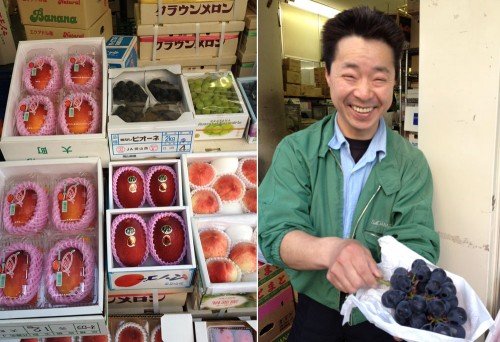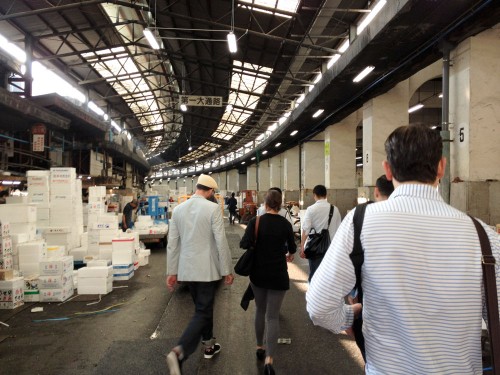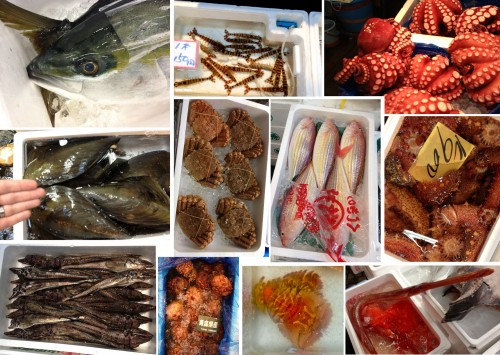by Dave Arnold

Tsukiji is the largest and most important of Tokyo’s wholesale markets. Unlike any other market I’ve visited, the selling at Tukiji is organized into auctions between large wholesalers and middlemen. These middlemen are still wholesalers in the US sense, and they resell their goods to smaller markets, restaurants, and consumers. You can read about the market structure in Tsukiji’s own words here.
Nastassia, Mark Ladner and I missed the famous tuna auction; but were able to see a vegetable auction:

It took quite a lot of control not to grab a box of wasabi and start running.

We also saw some nice fruit. The grapes on the right are Pione grapes — they cost 40 dollars a bunch, but they aren’t the most expensive grapes you can buy here. Some muscat grapes topped 260 dollars a bunch. I didn’t try those muscats, but piones are amazing. They have a concord-like nose and are perfectly balanced in sweetness and acidity. They are also very large and seedless, and their skins are thick but strangely pleasant. It was great experiencing the aroma of concord grapes –an early fall aroma for me — in early summer. Despite the expense, the Park Hyatt Tokyo bought flat after flat of these grapes for us to spin in the centrifuge and turn into clarified juice –thousands of dollars worth. We mixed the juice with vodka and carbonated it. We added no sugar and no acid. It was some good grape alco-soda.
Back to the main event: the fish market…
This place is extraordinarily clean. No part of it has any sort of off-smell.

The only detectable aroma in the fish section was that of the ocean. Not the slightly rotting aroma of the beach, just the dead clean smell of floating at sea. Neither Mark nor I could understand how the hell they pulled that off. How could the whole market be that well ventilated? This lack of smell was just one indication that the folks at Tsukiji were playing the market game on a completely different level than I’d seen before. At every step it seemed that the operators’ only considerations were how to increase the cleanliness and efficiency of the market and the quality of the product. Sounds great, but could have some bad ramifications if quality always trumps sustainability.
- Tsukiji uses more styrofoam than you can believe. Everything is packed in styrofoam –and many things are packed in plastic inside of styrofoam. The Tsukiji website says that all of the styro-packing is recycled daily, but I’d like to know more.
- Tsukiji uses crazy amounts of water. Everything is constantly hosed down and made immaculate. The floor of the market is so clean that the large blue-fin tuna are placed directly on it. When we eat tuna we are eating off that floor. I wish I could figure out how the water supply works.
- There does not seen to be any concern about the overfishing of certain species -most notably, blue-fin tuna. I asked my hosts if they were worried about the disappearance of the tuna — they said no, and joked that when they finally did run out everyone would be scrambling to eat the last one. Ha Ha…. wait.. That ain’t funny. I’d really wanted to know more about fishery conservation in Japan, but my ability to learn was hampered because I couldn’t speak Japanese. I’d love some informed comments.
All in all, the most impressive market I’ve ever seen.

Notice the yellow motorized cart in the upper left of the photo. These things are constantly zipping around the market. We had been warned — a warning I didn’t take too seriously — that we’d be in constant danger of getting run over. I should have been more afraid: these cart drivers are no joke. They won’t swerve out of their way to strike you, but they also won’t waver an inch off their desired path. They also don’t enjoy honking, warning, or yelling.
The whole “run you down” theme is evidence of the general fact that the folks at Tsukiji really don’t like tourists. We had to get favors pulled for us by the Park Hyatt in Tokyo to visit. Every year they tighten the tourism reigns a little tighter. Recently, I was told, flash photography was banned after a fish cutter hurt himself when a flash startled him. While safety should always come first, complaining about cutting yourself because someone took a photo is kinda sissy. Eventually I’m sure they’d like to abandon tourism at the market altogether, which would be a pity.
Here, a crew breaking down frozen tunas:

A video of that crew:
I particularly liked the way they manipulated the huge pieces of fish with these gaff-like knives:

The handles of these knives are awesome. They feel like a fine jewelry hammer in the hand. I almost bought one, but restrained myself — it is, sadly, not often that I am faced with band-sawing a whole frozen tuna at home.
The variety of fish on sale is mind boggling:

In particular, note the mussels as big as my head, the crabs in bondage, the crazy beak on that red fish, and the built in air-bubbler compartment in the Styrofoam prawn box.
Here is a video of individually packed live squid:
I love it but I’m not sure why.
And yes, I went to one of the great little sushi shops attached to the market:

I included a picture of the front — can someone identify this place for me?
Last but not least, the Ike Jime Man:
One of the main reasons I wanted to visit Tsukiji was to witness Japanese fish Killing (Ike Jime), first-hand. I was able to hang out and watch an expert for a few minutes. Here he is:

In my next post, I’ll share video of Ike Jime and discuss what I learned.

Just want to say although I rarely comment, your posts are always informative and interesting – ended up purchasing the documentary you last mentioned. Thank you so much 🙂
Was introduced to this site via an article regarding Booker and Dax, which I hope to visit on a future visit to NYC.
Hope to see you there
The shop is called “Iwasa Sushi”, and surprisingly has an English web page (http://www.iwasasushi.com/en/).
Most definitely want to see Ike Jime man in action.
I hadn’t heard of Tsukigi before this article, thank you! Amazing stuff. By the way, I miss seeing you sneak around the FCI… Please keep up with these great articles, pictures, and videos!
Wow! Great stuff!
Those gaff knives are used not only to handle fish but also to kill them before the ikejime process. A swift blow to the brain with the hook part does the trick.
Is this the sushi place you went to? http://r.tabelog.com/tokyo/A1313/A131301/13007649/ . The noren (entrance curtain) says ä½å£½ “satoshi”.
The “mussels” you mentioned are called “tairagigai” in Japanese and penshell in English. They have the best quality abductor muscle of any shellfish I have ever had.
Howdy, I’ve seen similar knives for sale on an Australian website for brain spiking fish, but I thought they were smaller. I wish I had bought one. Thanks for the info!
Can’t get enough pictures from Tsukiji, thanks. Agree, one of the most remarkable things about the place is the (lack of) smell. When you think what an ordinary fishmongers, or even the stall in a supermarket smells like…
In terms of future tourism to Tsukiji, they have been talking for a long while about moving the whole shebang to a site north of the city. There, they say, tourists will only be able to observe from overhead walkways. If it ever happens, what for me is the greatest food experience on earth, will have been lost.
And you are right in your observation about the Japanese’s disinterest in fish sustainability. It is simply not a subject that is discussed. We all have our taboos, I guess…
My Japanese sucks (1/2 Japanese 1/2 American Irish) so I asked my mother. Turns out your photo was missing part of the name. The name of the place is Iwasa Sushi.
http://www.iwasasushi.com/en/
For other Sushiya and restaurants in the that area go to http://www.tsukijigourmet.or.jp/list.htm
The site is in Japanese but some of the links have English translations.
Thanks!
I went to Japan two years ago, and Tsukiji was tops on the list of things to do. I even ate at that very same sushi shop. We had no issues visiting the market. We just strolled right in. (Also missed the auction. Also wanted to buy everything. They had some veggies that looked almost exactly like ramps.) We wandered the aisles in wonder much like you did. I was in Japan for ten days and shot >1500 pictures while I was there. I vowed to never make fun of Asian tourists who come here and seem to be taking pictures of every square inch of the city, as I behaved exactly the same way. Everything, every detail, was beautiful and amazing. Experiencing Tsukiji was the nec plus ultra.
Thanks for posting this, seeing it again through your eyes brings back great memories and reminds me that I absolutely must do something with all those photos…
Dave, great to see you back here again. About the Pione grapes – I was thrilled to read that you tried these. My parents have been living in Taipei for the last 5-6 years and when we visit, we get these huge bowls of Piones. The comparison to Concords is apt, although the flavor of Piones is finer and better-balanced, as you point out. I would love it if you could make a rotovap distillate of the aroma from those skins. It would be amazing and would probably make a great blending component – thinking of fig leaf, etc.
Howdy Kitchengrl,
I’d love to make that but I haven’t seen Piones here in the US. I have seen Kyoho’s but they were not as aromatic as the Piones I had in Japan.
I’ve really enjoyed reading your blog. Thanks for coming back.
I went to Tsukiji five years ago. I recall that we were greeted rather warmly; but, it likely helped that we had a two year old in a stroller with us.
The large knifes (swords) that are used in the market are rather impressive. photo
Also, I would agree with your statement about styrofoam. Here was my attempt to capture the scale of the operation.
photo
I like the sun streaming through the windows.
With reference to Japanese Fish Sustainability: My Mum lives in Sicily and during visits I have been told by locals on more than one occasion that all of their Tuna gets sent to Japan. Sicily then IMPORTS most of their Tuna from elsewhere for their own consumption! How true this is, is anyone’s guess.
My Uncle’s wife is a native in Japan and whenever they came here for a vacation Mrs. Himari always shop for Tuna in the market because she wants to cook a smoked tuna so I offered her my Emson Electric Smoker and it took almost 3 hours before the tuna was fully cooked and I can say the taste is superb with matching tomatoes and some oriental spices.